Pandemic Response – Field Stories from Telangana
By Team ECE (Early Childhood Education), Azim Premji Foundation, Sangareddy, Telangana
The world has not seen a greater crisis than the COVID-19 pandemic in this decade. This extraordinary situation requires an extraordinary response. The Sangareddy Team constituted a core group that did extensive discussions with government functionaries, Anganwadi teachers, and community members to analyse people’s needs. The Team did the required background verification checks for the identified needs by talking to NGOs, undertaking documentation verification, verification through local contacts, such as Anganwadi teachers, functionaries, sarpanches, ward members, etc. and by going to the field and talking to the community directly. Many of the team members volunteered to negotiate with vendors; and, to pack and distribute relief materials, in spite of being aware of the risks that they are putting themselves into. A crisis brings out the true colour of people, it is said. We realised that the Sangareddy Team has members with rainbow hearts!
The support provided has been broadly categorised in two areas, humanitarian support and healthcare support.
Humanitarian support
The lockdown affected the community more than COVID-19 itself. It revealed how the majority of the population is living (earning and spending on essentials) on a daily basis. When the economy comes to a standstill, the weakest take the blow. With very little cash, resources and rations to sustain them, they suffer in silence. The government support, unfortunately, is designed in a way that it reaches the neediest, last.
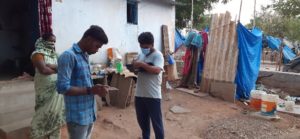
To meet the most essential needs of those in distress, dry ration items consisting rice, toor dal, wheat flour, oil, salt, turmeric, red chilli powder, coriander powder, onions, potatoes, detergent soap, and handwash were identified to be supplied.
Child Care Institutions (CCIs)
Child Care Institutions (CCIs) take care of children in need of care and protection. These are run by private NGOs and are monitored by the Department of Women Development and Child Welfare (WD&CW). They are mainly funded by donations made by public. Due to the lockdown, these institutions were facing funding issues and were running out of rations. The request for support came through the WD&CW Department. Dry rations (rice, dal, oil, and sugar) and milk packets for two months were provided to five child care institutions.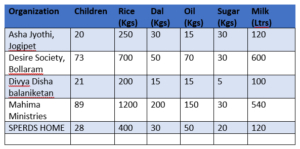 Old age homes
Old age homes
Dry rations (rice, dal, oil, and sugar) and milk packets for two months were provided to two old age homes run by private NGOs and monitored by the Department of Women Development and Child Welfare (WD&CW). The request for support came through the WD&CW Department. Shishu gruhas (government-run child homes)
Shishu gruhas (government-run child homes)
Shishu Gruhas are run by the WD&CW department for orphan and abandoned children. They requested to provide Lactogen and Cerelac for young children. Lactogen stage 1 (45 boxes) and Cerelac stage 1 & 2 (10 boxes) was provided.
Migrant families
The worst-hit during the lockdown were the migrant workers. They had come from different districts and states for doing construction work, making bricks in the brick kilns, powering the construction work being done in and around Hyderabad, and to work in various manufacturing industries dotting the Patancheru industrial belt. With construction work coming to a standstill and industries shutting down, these workers were stranded in the district as they were not able to travel back to their homes due to the lockdown. Their little savings could hardly sustain them for a few weeks. Government support was not reaching many of them due to remoteness and due to the fact that they are not accounted for in that locality.
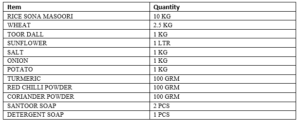
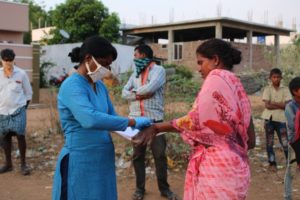
For some of the sites, the request for support came through the WD&CW Department, and some sites were identified by our team. Bags of groceries consisting of 12 items were distributed to 722 needy migrant families. These families were in and around Sangareddy town and at the brick kiln and near crushers sites in Patancheru.
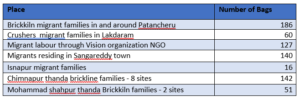
Madrassas
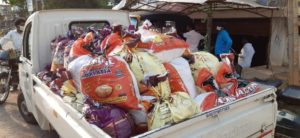
Seven private madrassa schools in the Sangareddy district had residential children who were not able to go back to their homes due to the lockdown. These madrassas were also facing a fund crunch due to the lockdown. The request for supporting these children came from the WD&CW Department.
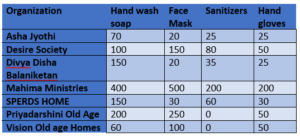 Through non-government organizations
Through non-government organizations
Society for Women’s Awareness and Rural Development (SWARD) that works in the Sangareddy district has a good network and carry out field-based work with women groups. They had identified 100 migrant families who required dry rations for taking them through the lockdown.

Healthcare support
Various hygiene aspects have gained focus in the past two months. The spread of COVID-19 can be reduced by focusing on hygiene practices like washing hands frequently using soap, covering mouth and nose using masks, and using sanitizers. Various groups of frontline workers (Anganwadi teachers, ASHA, and ANM workers), police personnel, doctors, nurses, etc. are exposed to high risk during the lockdown. Detailed below is the support given to them:
Hygiene supplies to frontline workers
Frontline workers such as Anganwadi teachers, ASHA, and ANM workers are exposed to high risks during the lockdown as they deliver the dry ration to pregnant women, lactating mothers and for children below 6 years at the doorsteps. They are involved in spreading awareness of hygiene practices and social distancing to the community members. They also need to ensure members who are in home quarantine are safe by doing checks on a regular basis. Training and capacity-building of frontline workers
Training and capacity-building of frontline workers
Hygiene material consisting of face masks, hand gloves, sanitizers, and Santoor soaps was distributed to the 1503 Anganwadi centres across the district to be used by Anganwadi teachers, Anganwadi helpers, and ASHA workers.
Five COVID-19 pandemic awareness posters on the themes of hand-washing, following physical distancing, and usage of masks and sanitizers were developed and shared with Anganwadi teachers, supervisors, CDPO’s across the district; and, among community members for creating awareness on hygiene and precautionary measures to be followed. These were shared through WhatsApp.
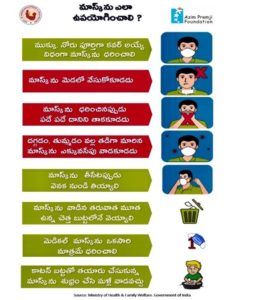
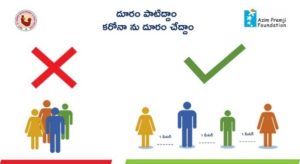
Awareness messages on physical distancing, how to use a mask, when to wash hands, and how to use a sanitizer.
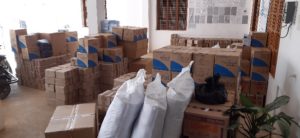 PPE Kits to health department
PPE Kits to health department
Doctors and nurses in the containment and quarantine wards were provided with 665 N95 masks and 995 PPE kits were supplied to the Sangareddy District Medical and Health department. Hygiene supplies to NGOs
Hygiene supplies to NGOs
Hygiene supplies consisting of face masks, hand gloves, sanitizers, and soap was distributed to seven NGOs. Hygiene supplies to government department
Hygiene supplies to government department
The Collector’s office, which was coordinating the pandemic efforts in the district, ICDS functionaries and the police department of Sangareddy district were provided with the hygiene material.
Stories from the ground
Hunger is forcing them to beg
‘We are labourers…not beggars’– is the response of the migrant labourers who are walking hundreds of kilometres to go to their homes. This displays their self-esteem. They are taking the long path regardless of the hardships they face while they are on the roads.
But it’s different for around 10 migrated families who are living shanties in Sangareddy. All of them are daily wage labourers. Due to the lockdown, they don’t have any work and so there are no earnings. They don’t want to go back to their homes because there are no means to travel and also the situation back home too is no better than here, they say.
They received 12 kg of rice for each person and Rs 500/- help from the government. But that did not help sustain for too long. Most of the families have young children who have good appetites as they play all day. The women could not see their children starving. The women and the children started begging for food in the lanes of the nearby colonies. Hunger made them roam the streets and beg for food.
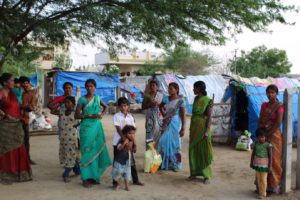
The team hurried the process of sorting and packing and distributing the ration kits after seeing them begging on the streets in their locality.
‘We want to go back home’
Yellaiah lives with his nine-member family in a small hut near a house construction site in Sangareddy. Seven of them are adults, and two are young children. They came from a village called Kadirabad, which is around 70 kilometres from Sangareddy. Before the lockdown, his three sons and two daughters-in-law used to work as daily wage labourers. Every day, they used to go to the labour adda and get work. Yellaiah used to work as a watchman for a house under construction. The young children were not attending Anganwadi or school. They play with the children from other huts and roam around in the space near the huts.
Due to the lockdown, all of them had to be at home. Now the only source of income is watering the building and watching the material for Rs 6000/- per month. When asked how their situation is, he told us that ‘so many stomachs are to be filled with the little we currently have. If we can go home, at least we can take a loan from people and survive. Here, we don’t know anyone who can support us.’
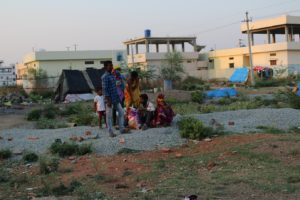
Along with Yellaiah’s family six other families, living in the shanties around, were given ration kits.s.
‘I like to spend my time in this dabba’
Mallesh irons clothes and has a dabba (a shop made of GI sheets) in Bank Colony, Sangareddy. He is from Pothireddipally village, which is almost a part of the Sangareddy town. He has one acre of agricultural land but gives it to other people for cultivation and gets nominal lease/rent pay for it. In general, he earns around Rs 1500/- per day by ironing clothes. He says that he is more comfortable doing this work than cultivation work in the field. There are five members in his family. His son also does the same job and his wife works as a housemaid.
Due to the lockdown and as a precaution, people stopped giving him clothes for ironing. So, he has no earnings. The same is the situation with his son. They got 12 kg of rice per person and Rs 500/- support from the state government. Now his entire family is dependent on his wife’s income.
When asked why he is sitting in the dabba even though he is not getting any clothes from people, he responded. ‘This is where I spend most of my time during the day. So, I like to sit in this dabba even if I don’t get clothes to iron.’ People display such attachment to the work that gives them bread and butter. He said that because of the virus, people are afraid of giving clothes for ironing. And he does not know much about how this virus spreads and what its impact is. He is hoping that people will start giving clothes again after a few days but is uncertain about how it is going it be.
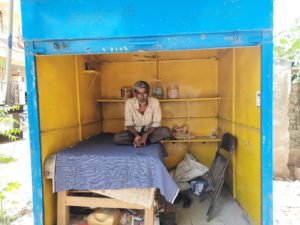
When asked if he need any support, Mallesh's response was that they are doing okay with the wife’s earnings. His only request was to tell people to give him clothes for ironing.
Not just from their villages, they are away from many things
There are always two sides of a coin and two versions of stories from the same context. And here the context is – the life of families working at brick kilns. One story is from the owner’s side and the other is from the worker’s side. But the one thing common in both stories is – they left their village, house, relatives and came along with their children to these sites to work.
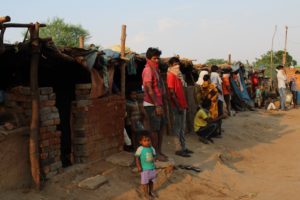
There are more than five hundred families working in brick kilns in and around Sangareddy. Many of them are from Andhra Pradesh, Orissa, and Maharashtra. In general, they migrate to Sangareddy to work in brick kilns for 6 to 7 months and then go back to their homes in May and again come back around October after the rainy season. They take an advance payment from the owners or contractors and work to repay it. Groups of a minimum of two people work as a team and make the bricks. They need to complete the entire cycle – making bricks with a processed mixture of mud, ash, and rice bran (alloy) and getting it dried and baked. Before baking, they stack the dried bricks in a specific pattern to count the number of bricks. The payment is made for 1000 bricks and this varies from site to site, based on the agreement. For a group of three skilled workers, it takes around 4 – 5 hours to make the wet bricks from the mud mixture.
Currently, work is going on at few sites; it has stopped at some sites as the summer season is almost ending, and at other sites, it has stopped due to a lack of transportation for the raw material because of the lockdown. The owners are ready to send them home and the workers are also ready to go home. But they cannot travel due to travel restrictions. They don’t want to walk with their families after listening to the hardships being faced by the migrants who left to walk their way back to their homes.
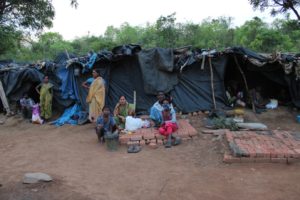
Many of these brick kiln sites are far away from villages and not accessible by public transport. So, they travel to the villages and towns only for specific purposes like health emergencies. They eat what they have, mostly, rice/roti and pickles. Many of them are not getting most of the services provided by the government, including health and nutrition support for women and children. The children are malnourished and are being brought up in unhygienic conditions.
The frontline workers, like Anganwadi teachers, and ASHA and ANM workers, say that it is difficult to reach them as they live far away from the centres. It entails a cost for them to reach their sites. The owners say that they take care of them in all ways, including giving them a weekly additional payment for buying food, groceries, and other items. They even say that they get vegetables to the sites and distribute them and arrange vehicles for emergencies.
The majority of the work that the workers do goes towards repaying the advance they take from the owners/contractors. All they think about is to work hard and get paid more so that they can pay off the advance and earn more. Hence, it is hard for them to get time and access to a better living when they are working at the sites. Whether they are aware of it or not, most of them are in need, in need of basic things like proper food and health services.
Gangaiah’s life as a stone crusher
Gangaiah, along with his five family members, lives in a hamlet near a stone crushing site in Lakdaram village. Sixty families are residing in the hamlet. All of them have migrated from Nanded, Maharashtra. Gangaiah has been living in this area for the past 17 years. He pays Rs 500/- per month rent for the land in which they have built their hut. Gangaiah and other people break stones in a quarry using manual tools, like hammer and drill. And these stones are sent to the stone crusher site. They get paid based on how many vehicles of stones they have loaded in a week. The vehicle can be a truck, a tractor, or an auto trolley. And based on the vehicle they load, they get Rs 200 – 400/-. The family members work as a group to break stones and load them into the vehicles.
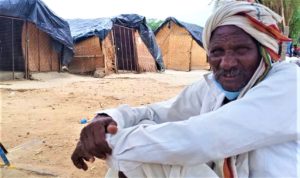
The stone breaking and loading is a tough job. Many of these crushers get injured while breaking big stones. Gangaiah has lost sight in his one eye and has many deep injuries because of this work. Though this is a job with a lot of unexpected dangerous situations, Gangaiah and other people are dependent on it for their livelihoods. When asked why they are not looking for some other work, he said, ‘This is the only skill we have got. We don’t have any agricultural fields or assets. We tried to join a nearby company to work, but we couldn’t build the required skills for that job. Our children also don’t have proper access to education due to lack of schooling in our mother tongue (Marathi) and resources.’
An Anganwadi near the site is providing health and nutrition services to young children and women. There is a school up to class VII run by an NGO. ‘Lifeline Missionary’ on CSR funds given by the companies in that area. When they reach 13-15 years of age, they will be taken along to work, or they will be left in their hometown for pursuing further education.
During the lockdown, their work has been stopped because of the suspension of transportation facilities. They have received 12 kg of rice and Rs 500/- support from the government. This made them sustain for a few days and now they are looking for help.
Their only hope is MGNREGA
Mangya Naik lives in Mumajipet Thanda, Lingampet Maldal, Kamareddy district in Telangana state. He has five members in his family- his wife, two daughters, and a son. He does farming and also works as a daily wage labourer. His wife also works along with him on the farms and goes for daily wage labour. His three children are studying. He has two acres of land. He is cultivating maize in one acre of land and has left the other acre of land empty due to water problems.
This year, his crop was affected due to a water crisis and he got only half of the production. Since there were no returns on the investment, he had no savings. Due to the lockdown, the couple also could not get any daily wage work. They were left with only Rs 300/-.
Mangya Naik told us that they got 12 kg of rice for each member and Rs 1500/- from the Telangana government. This has supported the family thus far, but they are not sure about how they are going to manage in the days to come. Bot, husband and wife, have registered for MGNREGA (Mahatma Gandhi National Rural Employment Guarantee Act) but there is, currently, no work in progress. They are many other families in the village who are in a similar situation and looking for support.
Team reflections
We were taking the details of families in one of the colonies in Sangareddy, where around 100 migrant families live. We wanted to get a number so that we could ask the vendor to prepare the ration kits. While taking the details, a mother, along with her two children, came running to us and told us that she lives a little far away from the colony, and no support is reaching them. We told her that we will surely come to her house and took her details. When we went back to the area, we took one kit on a bike and delivered it to her home. She looked happy and we realized how much it meant for her family.
When we were about to complete the distribution in that area, an old lady, along with her grandchild, came running to us, asking for support. She had managed to run around one kilometre to reach us. We told her that we have run out of kits and need to get them from the shop again. We took their details and promised to return with more kits. But when we went back, her hut was closed. We got the information that she had moved to the place where we had distributed the kits earlier in the hope of getting help. As it was late in the evening, we thought of giving it to her the next day. When we tried to reach her again, we found out that she had moved from that place too.
We could not reach her as we had to support other families working at the brick kiln sites around Sangareddy town. We regretted the same and finally, we were able to get her contact details and got to know she somehow went to her village as she was helpless in Sangareddy.
AUTHORS
ECE Team (Sangareddy). The Early Childhood Education (ECE) Initiative of the Azim Premji Foundation focuses on capacity development of teachers to become reflective practitioners with the aim to transform Anganwadi Centres into vibrant learning centres for the holistic development of children in the age group of 3-6 years.

